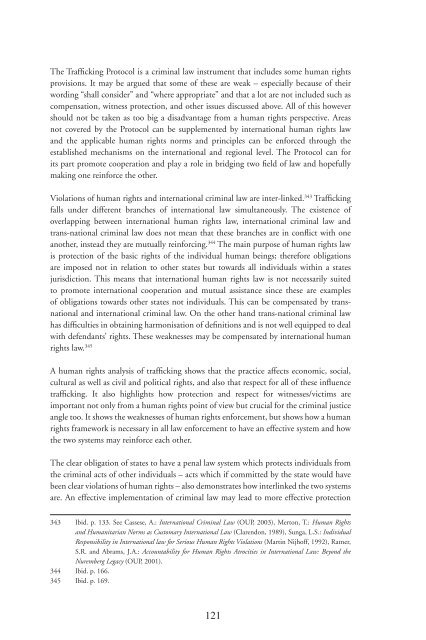Trafficking in human beings: human rights and ... - unesdoc - Unesco
Trafficking in human beings: human rights and ... - unesdoc - Unesco
Trafficking in human beings: human rights and ... - unesdoc - Unesco
You also want an ePaper? Increase the reach of your titles
YUMPU automatically turns print PDFs into web optimized ePapers that Google loves.
The Traffi ck<strong>in</strong>g Protocol is a crim<strong>in</strong>al law <strong>in</strong>strument that <strong>in</strong>cludes some <strong>human</strong> <strong>rights</strong><br />
provisions. It may be argued that some of these are weak – especially because of their<br />
word<strong>in</strong>g “shall consider” <strong>and</strong> “where appropriate” <strong>and</strong> that a lot are not <strong>in</strong>cluded such as<br />
compensation, witness protection, <strong>and</strong> other issues discussed above. All of this however<br />
should not be taken as too big a disadvantage from a <strong>human</strong> <strong>rights</strong> perspective. Areas<br />
not covered by the Protocol can be supplemented by <strong>in</strong>ternational <strong>human</strong> <strong>rights</strong> law<br />
<strong>and</strong> the applicable <strong>human</strong> <strong>rights</strong> norms <strong>and</strong> pr<strong>in</strong>ciples can be enforced through the<br />
established mechanisms on the <strong>in</strong>ternational <strong>and</strong> regional level. The Protocol can for<br />
its part promote cooperation <strong>and</strong> play a role <strong>in</strong> bridg<strong>in</strong>g two fi eld of law <strong>and</strong> hopefully<br />
mak<strong>in</strong>g one re<strong>in</strong>force the other.<br />
Violations of <strong>human</strong> <strong>rights</strong> <strong>and</strong> <strong>in</strong>ternational crim<strong>in</strong>al law are <strong>in</strong>ter-l<strong>in</strong>ked. 343 Traffi ck<strong>in</strong>g<br />
falls under different branches of <strong>in</strong>ternational law simultaneously. The existence of<br />
overlapp<strong>in</strong>g between <strong>in</strong>ternational <strong>human</strong> <strong>rights</strong> law, <strong>in</strong>ternational crim<strong>in</strong>al law <strong>and</strong><br />
trans-national crim<strong>in</strong>al law does not mean that these branches are <strong>in</strong> confl ict with one<br />
another, <strong>in</strong>stead they are mutually re<strong>in</strong>forc<strong>in</strong>g. 344 The ma<strong>in</strong> purpose of <strong>human</strong> <strong>rights</strong> law<br />
is protection of the basic <strong>rights</strong> of the <strong>in</strong>dividual <strong>human</strong> be<strong>in</strong>gs; therefore obligations<br />
are imposed not <strong>in</strong> relation to other states but towards all <strong>in</strong>dividuals with<strong>in</strong> a states<br />
jurisdiction. This means that <strong>in</strong>ternational <strong>human</strong> <strong>rights</strong> law is not necessarily suited<br />
to promote <strong>in</strong>ternational cooperation <strong>and</strong> mutual assistance s<strong>in</strong>ce these are examples<br />
of obligations towards other states not <strong>in</strong>dividuals. This can be compensated by transnational<br />
<strong>and</strong> <strong>in</strong>ternational crim<strong>in</strong>al law. On the other h<strong>and</strong> trans-national crim<strong>in</strong>al law<br />
has diffi culties <strong>in</strong> obta<strong>in</strong><strong>in</strong>g harmonisation of defi nitions <strong>and</strong> is not well equipped to deal<br />
with defendants’ <strong>rights</strong>. These weaknesses may be compensated by <strong>in</strong>ternational <strong>human</strong><br />
<strong>rights</strong> law. 345<br />
A <strong>human</strong> <strong>rights</strong> analysis of traffi ck<strong>in</strong>g shows that the practice affects economic, social,<br />
cultural as well as civil <strong>and</strong> political <strong>rights</strong>, <strong>and</strong> also that respect for all of these <strong>in</strong>fl uence<br />
traffi ck<strong>in</strong>g. It also highlights how protection <strong>and</strong> respect for witnesses/victims are<br />
important not only from a <strong>human</strong> <strong>rights</strong> po<strong>in</strong>t of view but crucial for the crim<strong>in</strong>al justice<br />
angle too. It shows the weaknesses of <strong>human</strong> <strong>rights</strong> enforcement, but shows how a <strong>human</strong><br />
<strong>rights</strong> framework is necessary <strong>in</strong> all law enforcement to have an effective system <strong>and</strong> how<br />
the two systems may re<strong>in</strong>force each other.<br />
The clear obligation of states to have a penal law system which protects <strong>in</strong>dividuals from<br />
the crim<strong>in</strong>al acts of other <strong>in</strong>dividuals – acts which if committed by the state would have<br />
been clear violations of <strong>human</strong> <strong>rights</strong> – also demonstrates how <strong>in</strong>terl<strong>in</strong>ked the two systems<br />
are. An effective implementation of crim<strong>in</strong>al law may lead to more effective protection<br />
343 Ibid. p. 133. See Cassese, A.: International Crim<strong>in</strong>al Law (OUP, 2003), Merton, T.: Human Rights<br />
<strong>and</strong> Humanitarian Norms as Customary International Law (Clarendon, 1989), Sunga, L.S.: Individual<br />
Responsibility <strong>in</strong> International law for Serious Human Rights Violations (Mart<strong>in</strong> Nijhoff, 1992), Ratner,<br />
S.R. <strong>and</strong> Abrams, J.A.: Accountability for Human Rights Atrocities <strong>in</strong> International Law: Beyond the<br />
Nuremberg Legacy (OUP, 2001).<br />
344 Ibid. p. 166.<br />
345 Ibid. p. 169.<br />
121

















